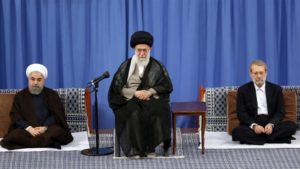Special to WorldTribune.com
Analysis by Fariborz Saremi
The Islamic Republic of Iran is witnessing a severe deterioration in all sectors, according to reports from political activists inside the country and a recent, in depth analysis by the leftist Tudeh Party of Iran.
In fact, the theocratic regime of Iran is living through a similar period experienced by the USSR before it collapsed, Ray Takeyh a senior fellow at the Council on Foreign relations wrote for the Washington Post on July 5, 2017.

Anticipating this eventuality, the U.S., neighbors in the region and the opposition inside the country are working to secure a peaceful transition of power in Iran.
Secretary of State Rex Tillerson told House Foreign Relations Committee on June 15, that the U.S. policy towards Iran is based on support of internal forces that can bring peaceful change in Iran.
Saudi Prince Turki Faisal Al Saud, former head of Saudi intelligence, participated in the Paris meeting of the exiled resistance group Mujahedeen-e-Khalq (MEK) on July 1, 2017, where he voiced support for opposition efforts to rid Iran of the “Khomeini Cancer”.
In a region with failed states and internal turmoil, Iran is often mentioned as a stable country and an island of stability,
“The history of the Islamic republic, however, is a turbulent one, featuring a constant struggle between an authoritarian regime and restive population seeking democratic empowerment,” Takeyh said.
Although there are reformists within the system, they have minimal power and have not been able to bring change to the political and economic status quo.
When the clerics first assumed power, they executed hundreds of followers of the Shah’s regime and officers of the Imperial Iranian Armed Forces. Their supporters waged bloody street battles to even repress other members of the revolutionary coalition who did not share the objective of a theocratic dictatorship. In the 1990’s, the reformists were active but failed to change anything.
Then came the Green Revolution in Summer 2009 that shook the system to its core and brought the Islamic Republic to the verge of collapse.
The one thing certain about Iran’s future is that another protest movement will rise at some point seeking to displace the regime.
Today, the Islamic Republic has a strong geopolitical position but socially, economically and politically is mired in crisis, reminiscent of the Soviet Union during its last years.
The regime can no longer fully trust the IRGC because many of its generals and officers are on the side of the people. The system is paralyzed by corruption, which is particularly problematic for a system that bases its power on divine authority.
President Hassan Rouhani is billed as a reformist but has not yet fulfilled his promises.
“Today, the Islamic republic will not be able to manage a succession to the post of the supreme leader as its factions are too divided and its public too disaffected,” Takeyh wrote.
The prospect of a banking crisis is so serious that in a speech earlier this year, the head of Iran’s central bank warned financial executives that non-performing loans were a threat to all the gains the Rouhani government is making on the economic front analyst Mostapha Hassan wrote in the July 25 edition of the Baghdad Post.
Rouhani has little time for real political and economic reforms, and the regime he serves faces a similar fate as the USSR.
For a peaceful transition of power in Iran that does not threaten the national integrity and the national unity of the country, activists are looking for leadership to emerge from inside the country rather than Diaspora.
Dr.Fariborz Saremi is a German-Iranian strategic analyst based in Hamburg Germany. He currently advises German parties on geopolitical issues, the Middle East and Iran and writes for several English language publications including WorldTribune.com and FreePressers.com.
